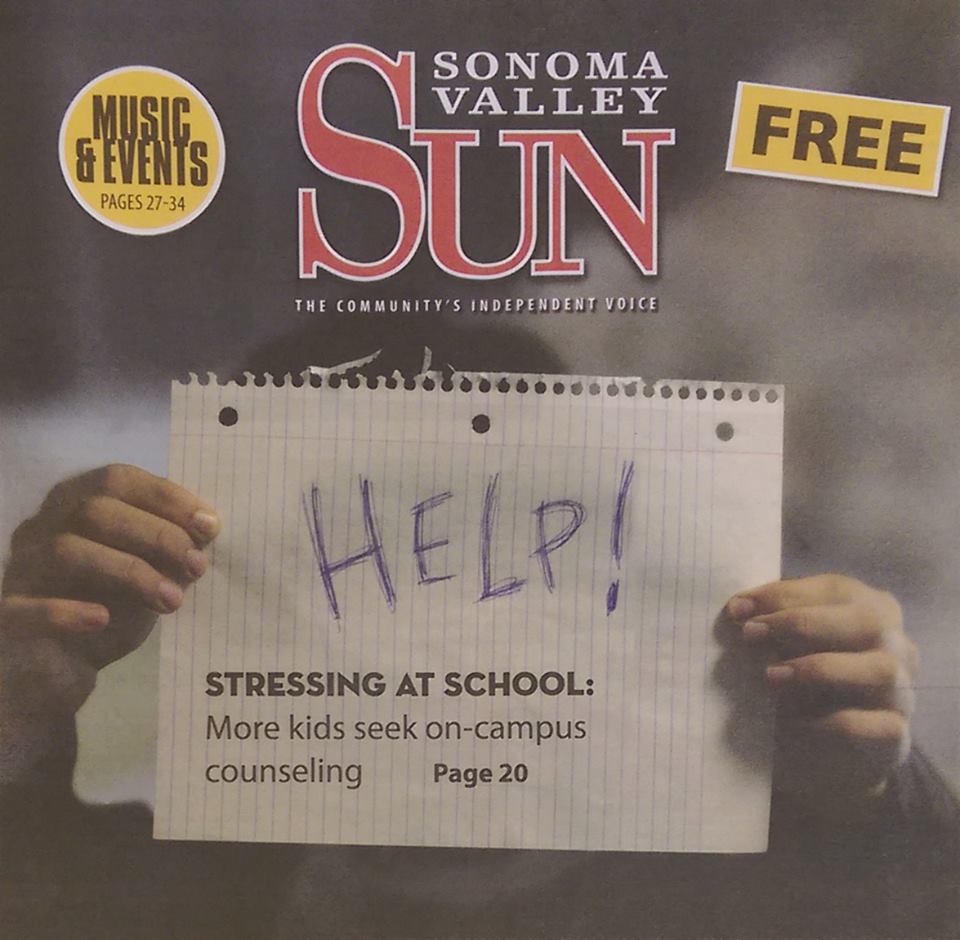Exclusive to the Sun by Stephanie Hiller
More students are making counseling requests at school, says District Superintendent Louann Carlomagno, and the district has taken steps to increase services. “We have added a second counselor at the high school level and two days more counseling time at each of the middle schools. And we still need more.”
Stress? Anxiety? Sensory overload? Whatever the reason, “It takes a lot of time and a lot of resources,” Carlomagno said, adding that more services from the hospital and the Sonoma Valley Health Center would be appreciated.
In addition to additional staff time, the District contracts with Social Advocates for Youth (SAY) to provide counseling on campus. The county’s Crisis Assessment and Prevention Education (CAPE) Team can also be called upon. But most counseling to students is paid for from the school’s budget. For all student support services, the District spends $672,000 a year, according to John Bartholome, Chief Business Official for the District.
Nikarre Redcoff, the District’s Director of Special Education, coordinates counseling services throughout the District. Yes, she said, the demand is increasing and it begins at a lower age. “When I first came to the District 21 years ago, the youngest child needing significant help was nine years old. Today that age has dropped to six.”
She did not have an explanation for this increase, which she said is occurring not only in Sonoma but Countywide, but the stressors on families since the 2008 economic decline may be a contributing factor; she emphasized that the need for help crosses all economic and ethnic boundaries. “We have families with stressors and it’s a very complicated dynamic,” she said, adding that she has “great sympathy for families.”
Redcoff echoed the belief expressed by other professionals in the County that increased requests for counseling might be a good thing. Student willingness to seek help, “may be a good sign,” said John Loughlin, director of Special Education at the County level, “that we are doing the right thing, and that the stigma of seeking counseling has been reduced.”
He praised Sonoma Valley’s response to kids’ expressed needs.
Loughlin explained that state legislation in 2011 shifted responsibility for counseling services from county mental health agencies to the schools. That, too, may be a good thing, noted Elizabeth Goldman, director of Counseling Programs at SAY, “because school is where kids are during the day,” and “kids can’t set aside what happens outside of school from their work in school.”
“If school becomes a place where someone will hear you, maybe you feel school is your community and you stay attached to school,” she said.
Goldman sees “an increase in awareness on the part of schools as to how trauma and negative life experiences can be barriers to learning.” She added, “I think there a lot of kids that need a lot of help.”
Early identification of kids who are stressed has become standard. The law requires that schools implement Educationally Related Mental Health Services (ERMS) as early as possible, because these disorders often worsen if left untreated.
The job of the schools is twofold, Redcoff said. “We need to keep our kids safe, and we need to educate them.”
School-based mental health services tend to be short term and are directed at helping the child be available for education. “You can’t have a child in a deep therapy session and then send him back to class and expect him to concentrate on his math lesson.” Hence help tends to focus on developing behavioral and cognitive strategies for dealing with stressors in a healthy way, rather than by acting out in class or withdrawing from activities.
“Some kids have learned maladaptive behaviors that have worked for them but they don’t work in the school setting. Kids can ask to go to the bathroom when they are stressed instead of throwing their papers on the floor so that they are asked to leave the classroom,” she said.
Though some might consider such disruptive behavior simply bad behavior, Redcoff emphasized that these are all learned strategies that may have worked once but are not working now. “I don’t look at any student as a ‘bad’ child,” she said. “Going to school is a student’s job. We want to help them be successful so that they can go on to be effective in college and career.”
According to the Anxiety and Depression Association based in Baltimore, anxiety disorders are the most common psychological disorder in the United States, affecting 40 million adults and one in eight children. “Research shows that untreated children with anxiety disorders are at higher risk to perform poorly in school, miss out on important social experiences, and engage in substance abuse,” and 60 to 80 percent are untreated, according to the 2015 Child Mind Institute Children’s Mental Health Report.
No one we interviewed could explain why anxiety disorders have risen so dramatically – five to eight times higher in adolescents now than 50 years ago. Redcoff chose her words carefully, reluctant to speculate. Counseling staff at the high school did not respond to repeated requests for interviews.
But Karin Davis, a licensed psychiatric social worker working in the Rohnert Park schools suggested that kids are under a lot of pressure today. “My nephew sometimes stays up until 2 a.m. to finish his AP homework,” she said. “School is very competitive.”
Another stressor, she suggested, is that “Kids are getting exposed to things much younger via social media and the internet.”
Peter Gray, in “Psychology Today,” referred to studies showing that anxiety and depression correlate with feelings of lack of control over externalities. Evidence shows that greater emphasis on external achievement tends to generate a sense of less control over one’s life. Gray suggests lack of self-directed free play in early childhood is the cause of anxiety disorders in adolescence.
Gray writes, “As a society we have come to the conclusion that children must spend increasing amounts of their time in the very setting where they least want to be. The cost of that belief, as measured by the happiness and mental health of our children, is enormous. It is time to re-think education.”
Or maybe, to re-think success.






Be First to Comment